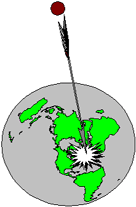Destruction by Impact
There has been a lot of discussion about the devastating effects that the impact of a small asteroid on the Earth would have on our civilisation. But why is this the case? After all, the asteroids of which we speak might typically be less than a kilometre in diameter. Even a small hill might be of similar size and have comparable mass.

The answer lies in the velocity of such an asteroid. The minimum velocity of an asteroid impact is 11 km/sec. This is speed acquired simply from the Earth's gravitation. The most probable velocity is somewhere between 15 and 30 km/sec. These velocities, which are far greater than anything we usually experience, are termed hypervelocities.
Now the destructiveness of an impact is proportional to the energy that the object releases on impact, and this is essentially the energy that the body possesses by virtue of its motion - its kinetic energy, which is given by the formula:
K = 1/2 m v2
where m is the mass of the object and v is its velocity. The mass of an asteroid depends on its density and thus its composition. The most common asteroids are believed to have 'rock-like' densities of around 2500 kg/m3.
Note that this energy is proportional to the square of the velocity. This is what makes a hypervelocity impact so devastating. For every doubling in velocity, the energy, and thus the destructiveness of the impact, quadruples. Only the explosion of a nuclear bomb releases energy comparable to a hypervelocity impact, and even the largest thermonuclear bombs in current military arsenals never reach the destructiveness of asteroids more than 100 metres in diameter.
The table below lists the kinetic energy, in megatons TNT equivalent, of various diameter asteroids with this density:
| Diameter (metres) | Mass (million tons) | 15 km/sec | 20 km/sec | 25 km/sec | 30 km/sec |
|---|---|---|---|---|---|
| 100 | 1.3 | 35 | 62 | 97 | 140 |
| 200 | 10 | 280 | 500 | 780 | 1,100 |
| 300 | 35 | 950 | 1,700 | 2,600 | 3,800 |
| 400 | 84 | 2,200 | 4,000 | 6,200 | 9,000 |
| 600 | 280 | 7,600 | 13,000 | 21,000 | 30,000 |
| 800 | 670 | 18,000 | 32,000 | 50,000 | 72,000 |
| 1,000 | 1,300 | 35,000 | 62,000 | 97,000 | 140,000 |
| 2,000 | 10,000 | 280,000 | 500,000 | 780,000 | 1,100,000 |
| 3,000 | 35,000 | 950,000 | 1,700,000 | 2,600,000 | 3,800,000 |
| 4,000 | 84,000 | 2,200,000 | 4,000,000 | 6,200,000 | 9,000,000 |
| 5,000 | 160,000 | 4,400,000 | 7,800,000 | 12,000,000 | 18,000,000 |
| 6,000 | 280,000 | 7,600,000 | 13,000,000 | 21,000,000 | 30,000,000 |
| 7,000 | 450,000 | 12,000,000 | 21,000,000 | 33,000,000 | 48,000,000 |
| 8,000 | 670,000 | 18,000,000 | 32,000,000 | 50,000,000 | 72,000,000 |
| 9,000 | 950,000 | 26,000,000 | 45,000,000 | 71,000,000 | 100,000,000 |
| 10,000 | 1,100,000 | 35,000,000 | 62,000,000 | 97,000,000 | 140,000,000 |
Thus a small 100 m diameter asteroid with a mass of 1.3 million tons will have a kinetic energy of typically 62 megatons of TNT explosive. Enough to destroy a city! A 10 kilometre monster would deliver around 100,000 gigatons of TNT explosive!
Material prepared by John Kennewell





